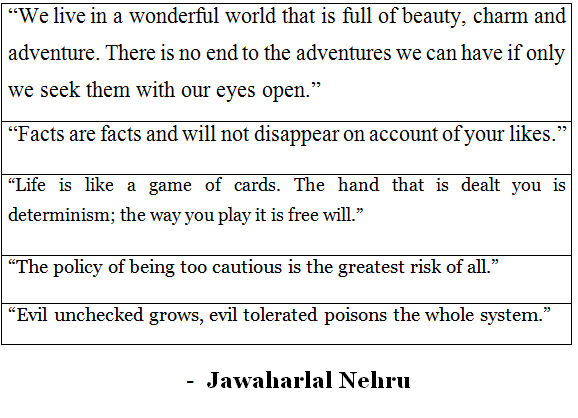Jawaharlal Nehru: Biography, Quick Facts, and Major Achievements
Jawaharlal Nehru was one of the most influential Indian nationalists. With the support and mentorship he received from Mahatma Gandhi, Nehru came to lead Indian National Congress, tentatively moving the party to social democratic policies. An important member of the Indian independence movement, Nehru devoted his political career pursuing a united, modernized and independent India. After countless intensive non-violent campaigns and the ‘Quit India’ movement of 1942, Britain finally budged and granted India her independence on August 15, 1947. Nehru became the first Prime Minister of India, serving from 1947 until his death in 1964.
Quick Facts about Jawaharlal Nehru (1889-1964)
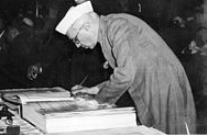
Image: Nehru signing the Indian Constitution
Birthday – November 14, 1889
Place of birth – Allahabad (Prayagraj) India
Died – May 27, 1964
Place of death – Delhi, India
Parents – Motilal Nehru and Swarup Rani Nehru
Siblings – Vijaya Lakshmi, Krishna Hutheesing
Spouse – Kamala Nehru
Daughter – Indira Gandhi
Education – Trinity College, Cambridge; Harrow School in London
Political Party – Indian National Congress
Elected offices – Prime Minister of India (1947-1964)
Most famous for – India’s first Prime Minister
Nicknames – Chacha Nehru, Pandit Nehru
Notable works – Letters from a Father to His Daughter (1929), An Autobiography (1936), the Discovery of India (1946)

Jawaharlal Nehru’s Speech at Columbia University (1949)
Nehru: Summary
Two years after becoming India’s first prime minister, in 1949, Jawaharlal Nehru gave a speech at Columbia University, emphasizing the need for India to have peace in order to fully actualize its true potential. The speech, one of many famous speeches of this Indian Independence leader, highlights some of the visions that Nehru had for his country. An Indian nationalist, Jawaharlal Nehru was an important member of the Indian Independence Movement that included the likes of Mahatma Gandhi, Dr. B.R. Ambedkar, and R. Venkataraman. Having had his tertiary education in England, Nehru returned to India in the early part of 1912 and began his decades’ long fight for the complete independence of India from colonial power Britain.
As prime minister of India, Nehru crafted a neutralist foreign policy which enabled him to receive enormous acclaim from member countries of the Non-Aligned Movement. He was also praised for injecting secularism and other liberal democratic principles in a bid to make India a leading role on the international front.
What other feats was Jawaharlal Nehru most famous for? And just how impactful was his tenure as prime minister of India? Below, World History Edu presents the 10 major achievements of Jawaharlal. But first, here is a quick biography of the life of this Indian Independence movement leader.
Quick Biography
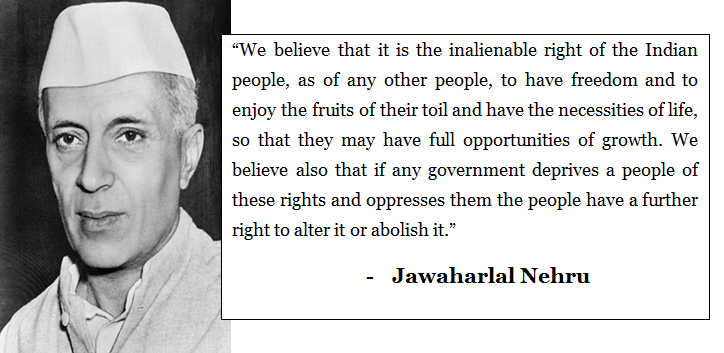
Jawaharlal Nehru – biography, facts, and achievements
Nehru was born in Allabhad to a family of Brahmans community. In India’s caste system, the Brahmans are considered the highest ranking class in India most known for religious, administrative, and academic scholarship. Nehru thus grew up in a family of intellectuals; for example, his father Motilal Nehru was a famous lawyer and one of the earliest members of the Indian independence movement. Motilal, who was also associated with Mahatma Gandhi, served as the president of the Indian National Congress on two occasions – 1919 and 1928.
Jawaharlal’s mother, Swarup Rani Thussu, was a member of a very influential Kashmiri Brahmin based in Lahore (in present day Pakistani province of Punjab).
Jawaharlal had two siblings, including his sister Vijaya Lakshmi, who went on to become the first woman to lead the United Nations General Assembly. His other sister Krishna Hutheesing established herself as a writer of many books, particularly about her brother Jawaharlal.
He grew in a very affluent and privileged family. He received his formative education at home until his mid-teens before proceeding to study in the United Kingdom at Harrow in 1905. From 1907 to 1910, he earned a honors degree in natural science at Trinity College in Cambridge.
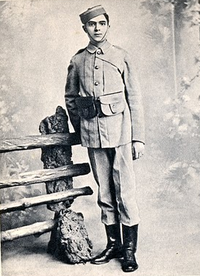
Nehru dressed in a cadet’s uniform at Harrow School in England
After his studies at Inner Temple, London, he was called to the bar in 1912. He would then take up a job as an advocate of the Allahabad High Court.
He got married to Kamala Kaul in 1916. By his wife Kamala, he gave birth to one daughter – Indira Priyadarshini (later Indira Gandhi), who also went on to become Prime Minister of India.
Nehru and his wife had a son who only survived for about a week after birth.
Following the assassination of his daughter Prime Minister Indira Gandhi, Jawaharlal Nehru’s grandson Rajiv Gandhi served as prime minister from 1984 to 1989.
Nehru and Mahatma Gandhi
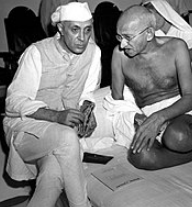
Jawaharlal Nehru gained his formative experience in politics from Mahatma Gandhi who was about 20 years his senior. Image – Gandhi and Nehru during the drafting of Quit India Resolution in Bombay, August 1942,
After training as a barrister at the Inner Temple, London, Jawaharlal returned to work at the Allahabad High Court, where he quickly became very uninterested in practicing law. Unlike his father, he wanted to devote his whole career to working for India’s independence struggle. Initially, he was clueless as to how to realize this dream of his, thus until he met Mahatma Gandhi in 1916. His father and Gandhi are credited with instilling in Jawaharlal the courage to remain resolute in the pursuit of independence from Britain.
10 Major achievements of Jawaharlal Nehru
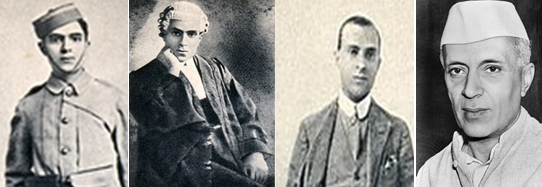
Jawaharlal Nehru – history and achievements
Fought against indentured labor and labor and civil rights abuses in India
In 1912, Jawaharlal Nehru joined the activities of the Indian National Congress. Initially he was not so pleased by what he termed as “an English-knowing upper-class affair” in the party. However, in time he came to immerse himself deeply in the civil rights campaigns of the party. On so many occasions he campaigned against practices like indentured labor in India.
During World War I, he offered his services to the St. John Ambulance as a secretary in Allahabad. He and many of his associates from Indian ruling upper classes were vocal against the colonial government’s censorship acts.
A prominent member of India’s Nationalist movement that wanted self-rule immediately
Contrary to what moderate Indian political activists like Gopal Krishna Gokhale, Nehru gravitated towards radical independence activists like Bal Gangadhar Tilak (1856-1920), a man Gandhi described as the “Maker of Modern India”. He had no trust in the western institutions to deliver the necessary political, social and economic reforms that India longed for. He was completely in favor of non-cooperation policies that he hoped would pile up the pressure on Britain to grant Indian self-rule.
Nehru’s slightly radical views were even in contrast to the moderate views his father held. His time spent abroad somehow made a bit discontented with the pace at which India’s journey to self-rule was moving.
Following the death of moderate activist Gokhale in 1915, the national movement was taken over by anti-moderates like Annie Besant and Bal Gangadhar Tilak, two very important people that Nehru drew a lot of inspiration from.

In the late 1920s, he established the Independence for India League within the Indian National Congress. The goal of the league was to put pressure on Britain to grant India Dominion status immediately. His mentor Gandhi however gave Britain within two years to grant India Dominion status.
Nehru campaigned for unity and dialogue between the Hindus and Muslims
Right from his formative years in politics, Nehru always stood in support of Hindu-Muslim unity and dialogue. He supported the Lucknow Pact of 1916 which was an agreement between his party the Indian National Congress and the Muslim League. He reasoned that through pacts of such nature, the nationalist movement would fare better in its quest for at least a Dominion status within the British Empire. Nehru’s efforts, as well as efforts from both nationalist members from both sides, helped in establishing friendly ties between Hindus and Muslim independence activists. Prior to the Lucknow Pact, the two sides considered each other as enemies.

In his 1929 policy draft document for the Congress, he included a number of things that an Independent India would push for. Some of those goals were freedom of religion; equality before law without distinction to color, creed, or caste; and socialism. His draft influenced the “Fundamental Rights and Economic Policy” resolution that got ratified in 1931 by the party.
Jawaharlal Nehru participated fully in the activities of the non-cooperation movement
Beginning around 1920, Nehru had started getting frustrated with the British government dragging its feet in granting India Dominion status or self-government. The young and energetic political activist joined forces with members of the non-cooperation movement in the United Provinces (today’s Uttar Pradesh) to call for Indian unity in resisting Britain.
His actions resulted in him getting arrested for a few months. On February 4, 1922, police violently responded to non violent protests by members of the non-cooperation movement at Chauri Chaura (in modern-day Uttar Pradesh). The protests soon devolved into reprisal attacks from demonstrators, who set ablaze a police station. Taken aback by the deaths of 22 policemen and three civilians, Gandhi called off the activities of the non-cooperation movement nationwide.
Believing that India’s independence struggle was in many ways tied to independence struggles in other parts of the world, Nehru worked in cohort with many international organizations fighting against imperialism and domination. Nehru was sent to Brussels as the representative of the Indian National Congress. He would go on to serve as a member of the Executive Council of the League in Brussels that campaigned against imperialism.
He was elected president of the Indian National Congress
Having properly joined the activities of the Congress Party around the late 1910s, shortly after the end of World War I, Nehru’s election as the president of the Congress in 1929 was one of great feat. No sooner had he taken that position than did he call for complete independence in a resolution before Congress. As a sign of his unbridled determination, he raised the Indian flag upon the banks of the Ravi in Lahore. Soon many nationalists and Congress members began flying the flag of India on buildings around the country.
Nehru’s reputation as the de facto leader of the independence movement was indeed boosted by the 1929 declaration of independence in the Lahore session of the Congress. He thus became Gandhi’s political successor.
With the help of some members of the Congress Socialist Party group, Nehru was able to get elected as president of the Congress from 1936 to 1937.
Nehru was part of the Salt March in 1930
In 1930 Gandhi started a civil disobedience drive to protest the British government’s tax on salt. Nehru and other members of the Congress joined the nonviolent protest. He even participated in the manufacturing of the contraband salt, an activity which got him arrested by the authorities. The Indian independence activists were fighting for Indians to have the right to make salt for domestic use. Nehru was able to rally the village folks to fight against a government that had taken away their dignity through oppressive economic and political policies.
The Salt March, also known as the salt satyagraha (i.e. a passive resistance to salt tax), had a huge impact in raising the issue of India’s independence around the world. On March 5, 1932, the Gandhi-Irwin Pact was born after Gandhi and Lord Irwin, British viceroy of India, were able to come to an amicable solution to end the civil disobedience (satyagraha).
Supported the fight against fascism
When World War II broke out in 1939, he called on all Indians to throw their weight in support of Great Britain and other democratic countries against fascism and dictatorship. His support for Great Britain came despite Viceroy Linlithgow not consulting elected Indian representatives of Britain’s intention to get India involved in the war. In exchange for India’s support, Nehru outlined a set of conditions that Britain ought to meet. Those conditions were: granting full independence to India after the war; and the participation of Indians in the central administrative and military branch of government. In spite of those demands being rejected by Linlithgow, Nehru called on all independence activists to remain on the side of democratic countries.
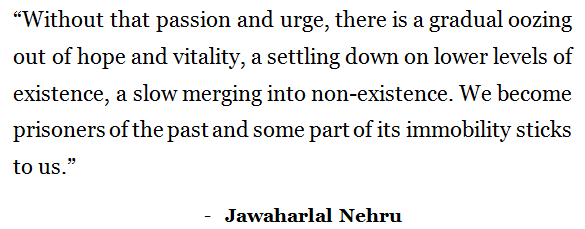
In October 1940, he was slapped with a four-year prison sentence because he of his civil disobedience campaign. His release came in December, 1941.
Jawaharlal Nehru was heavily involved in the Quit India Resolution of 1942
On August 8, 1942, the Indian National Congress passed the Quit India resolution to pile up the pressure on Britain for independence. Because Nehru and Gandhi were at the forefront of the resolution, the two men, as well as other prominent leaders of the Congress, were given prison sentences. In Nehru’s case he stayed behind bars until June 1945. It was Nehru’s longest prison sentence.
He led the Indian National Congress to victory in the 1946 provincial assembly election
In 1946, Nehru and the Congress welcomed the election plan proposed by the British Cabinet Mission to India. At the polls, Nehru and the Congress secured majority of the seats in assembly before going on to form an interim government with Nehru at the head.
First Prime Minister of India
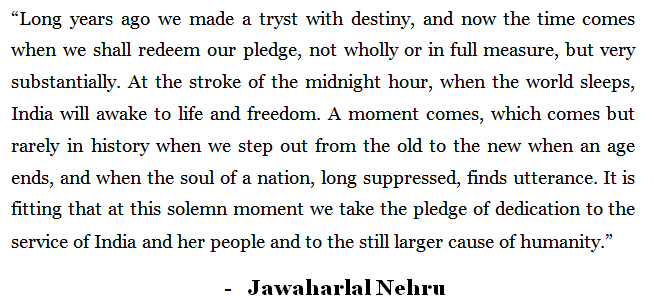
Jawaharlal Nehru’s “Tryst with Destiny” speech
On August 15, 1947, he was sworn in as the first Prime Minister of an independent India. The swearing in ceremony was done by Lord Moutbatten. His inauguration ceremony is most famous for the “Tryst with Destiny” speech. In the speech, he pledged to be resolute in serving the country.
Nehru led the Indian National Congress to victory at the polls in 1952, 1957 and 1962. In all those elections, his party secured majority of the seats in the National Assembly. For example, in 1957, his party secured 371 out of the 494 available seats in parliament. The Indian National Congress had about five times more seats than the second largest party in India at the time – the Communist Party.
Nehru was one of the founding fathers of the Non-Aligned Movement of nations
Nehru’s government had strong admiration for nations did not align themselves neither to Pro-soviet communist bloc (Warsaw Pact) and the pro-American capitalist bloc (NATO). He attended the Bandung Conference in 1955 in Indonesia, where representatives from many African and Asian nations met to discuss the adoption of a non-aligned stand to the then-raging conflict between the Soviet Union and the United States.
On the basis of the decisions that were taken at that Asian-African Conference, the Non-Aligned Movement was born in 1961 in Belgrade, Yugoslavia. Nehru cooperated with many leaders like Ghana’s Kwame Nkrumah, Egypt’s Gamal Abdel Nasser, Indonesia’s Sukarno, and Yugoslavia’s Josip Broz Tito in pushing against imperialism, colonialism, racism and foreign aggression, and occupation.
Nehru’s Accomplishments as Prime Minister of India
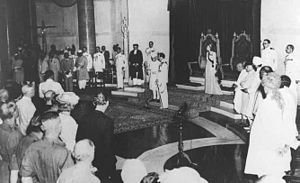
Lord Mountbatten swears in Jawaharlal Nehru as the first Prime Minister of independent India on August 15, 1947
He abolished the divine rights of kings in princely states. Upon India becoming a republic, those states joined the Indian republic.
For many years, Nehru worked with many Indian politicians to come out with a new constitution to replace the Government of India Act 1935. After India became independent in 1946, the need for a new constitution became even more apparent. On January 26, 1950, Nehru’s efforts paid off, as India adopted a new constitution.
He developed a national philosophy underpinned by modernism and secularism. Nehru also had things like parliamentary democracy, science and technology, and industrialization as the goals for the new nation.
On the economic front, he tried to boost India’s manufacturing capacity so that the dream of import substitution could be realized. Under his terms as prime minister, a lot of investments were made into industries like steel, coal, and iron.
His non-alignment policy during the Cold War augured very well for India. He was able to draw investors from countries aligned either to the Soviet Union and the United States. It has been estimated that India’s industrial output clocked an average of 7% growth annually during his time in charge. Regarding the size of the economy, Nehru was able to achieve about 4% growth in the Gross Domestic Product (GDP) of India.
He instituted a number of very crucial land reforms that enabled the agricultural sector to grow remarkably. For example, in spite of strong resistance from powerful landowners in the rural areas, he abolished the large landholdings, allowing lands to be redistributed in such a manner that it helped the total yield produced in year to increase. To inject science and technology into the industry, he established a number of agricultural universities, which produced high-yielding varieties of crops such as legumes and cereals.

Dwight D. Eisenhower on Jawaharlal Nehru, November 27, 1958
Firmly of the view that education was the only way India could transform itself into an industrialized and high income country, Nehru invested heavily into the education sector. Many institutions of higher learning were established, with special focus on medical sciences, technology, business, and economics. During his terms as prime minister, school enrollment in the rural areas shot up tenfold. The increase in school enrollment was due to his free and compulsory primary education policy. His government even offered free meals to schools in the most impoverished of areas in India.
Nehru’s foreign policy was aimed at building economic and cultural cooperation with nations from Asia and Africa. He took a neutral position as the Cold War raged between the communist bloc, led by the Soviet Union, and the capitalist bloc, led by the United States. Nehru joined the Commonwealth of Nations due to his strong desire work with British Commonwealth countries, many of which were in Africa, with regard to his anti-colonialism and anti-imperialism foreign policy initiative.
Nehru introduced a number of reforms in the country’s marriage, inheritance and property laws. For example, his government criminalized the country’s caste system of discrimination. Under his regime, women were given equal legal and social rights. For example, he reformed the ancient Hindu civil code, allowing Hindu widows to receive equal rights as men when it came to inheritance issues.
It was during his term as prime minister that Hindi was adopted as the lingua franca of India. This decision came in 1950. He passed the Official Languages Act in 1963 to allow English remain as an associate official language official language of the nation. Nehru is therefore responsible for the bilingualism that we see in India today.

Frustrated by Portugal’s refusal to leave its colony of Goa, Nehru was left with no other option than to order a military occupation of Goa in December 1961 before successfully annexing the region. His goal in invading Goa was to dislodge the Portuguese since they did not want to go peacefully like the French and the British had done post-India’s independence.
Death of Jawaharlal Nehru
Beginning around 1962, Nehru’s health began to deteriorate, perhaps due to the Sino-Indian War of 1962. The prime minister suffered his first mild stroke in 1963. On May 27, 1964, he died after suffering his third and final stroke. He was given a full state burial and thereafter his body was cremated in accordance with Hindu rites. The cremation was witness by close to 2 million mourners.
More Jawaharlal Nehru facts
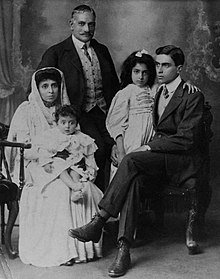
Nehru’s family – (L-R): Swarup Rani Nehru, Motilal Nehru, Krishna, Vijaya Lakshmi and Jawaharlal
It was during Nehru’s third term as prime minister that the Sino-Indian War of 1962 broke out. Nehru had set up military outposts in many disputed areas along the China-India border. The Chinese then responded by attacking those outposts. This marked the beginning of the Sino-Indian War of 1962, which saw India’s unpreparedness and ill-equipped army defeated by the Chinese Army. The defeat prompted Nehru to introduce several reforms to modernize the country’s military and defense policy.
During his time as prime minister, he survived four assassination attempts. The first was in 1947 when he was on a visit to what is now Pakistan. The second and third assassination attempts on Nehru’s life took place in 1955 and 1956 respectively. The fourth one came in Maharashtra in 1961.
Following the assassination of Gandhi on January 30, 1948, Nehru and the Indian National Congress set out to suppress many radical groups and religious paramilitary groups. Gandhi’s death also allowed Nehru’s government to unite the country under a single vision.
He was key in helping the Congress party win big in the 1937 provincial elections. The Indian National Congress emerged as the majority party in the various provinces across India.
Right from the mid-1930s, Nehru was the one who handled the foreign policy and affairs of the Indian National Congress. Additionally, he was tasked to make plans for how the economy of an independent India would like. He performed this task with the help of the National Planning Commission.
Nehru’s activism was not only restricted to territories controlled by the British government, but he also tried very hard to champion the rights and freedoms of Indians living in princely states. He collaborated with the All India States Peoples Conference to work towards this particular goal of his. His goal was to facilitate the integration of those princely states into national agenda.
People who influenced Jawaharlal Nehru
In addition to his father, Motilal Nehru, and Mahatma Gandhi, Nehru was influenced by a number of politicians and authors, including the following:
Majority of Jawaharlal Nehru’s tutors at home were English governesses and tutors. Some of those tutors included Irish Belgian tutor Ferdinand Brooks and Annie Besant. The latter was a family friend famous for being a British socialist, women’s rights activist, writer, and orator. Besant was also active in campaigning for Irish and Indian self-rule.
Nehru took a lot of inspiration from Buddhist and Hindu scriptures. He was also influenced by the works of British historian and academic G.M. Trevelyan (i.e. Garibaldi books), Irish playwright and political activist Bernard Shaw, English writer Herbert George Wells, English economist John Maynard Keynes, and English journalist and editor Meredith Townsend.
Famous quotes by Nehru
